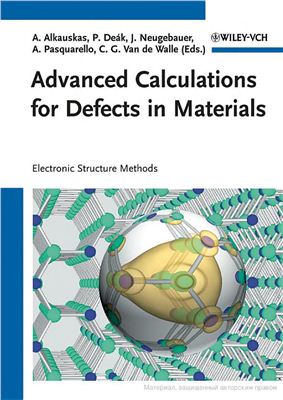Wiley-VCH Verlag, 2011, 384 pages
Defects and impurities are critically influencing the properties of materials. Increase in computing power and the development of efficient algorithms indicate a promising future for computational defect science. This book surveys recent advances in electronic structure methods. The application of hybrid functionals, the LDA+U method, time-dependent DFT, quantum Monte Carlo, and many-body perturbation theory are described and assessed. Methods to treat large systems and temperature effects, as well as finite size effects in modeling are also reviewed. The book provides an introduction for novices and a guidance for practitioners in theoretical and computational defect physics.
The editor, all authorities in this field, have selected respected scientists as chapter authors to provide and expert view of the latest advances. The result is a clear overview of the connections and boundaries between methods, as well as the broad criteria determining the choice between them for a given problem.
From the contents:
Advances in Electronic Structure Methods for Defects and Impurities in Solids
Accuracy of Quantum Monte Carlo Methods for Point Defects in Solids
Electronic Properties of Interfaces and Defects from Many-Body Perturbation Theory: Recent Developments and Applications
Accelerating GW Calculations with Optimal Polarizability Basis
Calculation of Semiconductor Band Structures and Defects by the Screened Exchange Density Functional
Accurate Treatment of Solids with the HSE Screened Hybrid
Defect Levels Through Hybrid Density Functionals: Insights and Applications
Accurate Gap Levels and their Role in the Reliability of Other Calculated Defect Properties
LDA+U and Hybrid Functional Calculations for Defects in ZnO, SnO2 and TiO2
Critical Evaluation of the LDA+U Approach for Band Gap Corrections in Point Defect Calculations: The Oxygen Vacancy in ZnO – a Case Study
Predicting Polaronic Defect States by Means of Generalized Koopmans Density Functional Calculations
SiO2 in Density Functional Theory and Beyond
Overcoming Bipolar Doping Difficulty in Wide Gap Semiconductors
Electrostatic Interactions between Charged Defects in Supercells
Formation Energies of Point Defects at Finite Temperatures
Accuracy Kohn-Sham DFT with the Speed of Tight Binding: Current Techniques and Future Directions in Materials Modelling
Ab Initio Green’s Function Calculation of Hyperfine Interactions for Shallow Defects in Semiconductors
Time-Dependent Density Functional Study of the Excitation Spectrum of Point-Defects in Semiconductors
Which Electronic Structure Method for the Study of Defects: A Commentary
Defects and impurities are critically influencing the properties of materials. Increase in computing power and the development of efficient algorithms indicate a promising future for computational defect science. This book surveys recent advances in electronic structure methods. The application of hybrid functionals, the LDA+U method, time-dependent DFT, quantum Monte Carlo, and many-body perturbation theory are described and assessed. Methods to treat large systems and temperature effects, as well as finite size effects in modeling are also reviewed. The book provides an introduction for novices and a guidance for practitioners in theoretical and computational defect physics.
The editor, all authorities in this field, have selected respected scientists as chapter authors to provide and expert view of the latest advances. The result is a clear overview of the connections and boundaries between methods, as well as the broad criteria determining the choice between them for a given problem.
From the contents:
Advances in Electronic Structure Methods for Defects and Impurities in Solids
Accuracy of Quantum Monte Carlo Methods for Point Defects in Solids
Electronic Properties of Interfaces and Defects from Many-Body Perturbation Theory: Recent Developments and Applications
Accelerating GW Calculations with Optimal Polarizability Basis
Calculation of Semiconductor Band Structures and Defects by the Screened Exchange Density Functional
Accurate Treatment of Solids with the HSE Screened Hybrid
Defect Levels Through Hybrid Density Functionals: Insights and Applications
Accurate Gap Levels and their Role in the Reliability of Other Calculated Defect Properties
LDA+U and Hybrid Functional Calculations for Defects in ZnO, SnO2 and TiO2
Critical Evaluation of the LDA+U Approach for Band Gap Corrections in Point Defect Calculations: The Oxygen Vacancy in ZnO – a Case Study
Predicting Polaronic Defect States by Means of Generalized Koopmans Density Functional Calculations
SiO2 in Density Functional Theory and Beyond
Overcoming Bipolar Doping Difficulty in Wide Gap Semiconductors
Electrostatic Interactions between Charged Defects in Supercells
Formation Energies of Point Defects at Finite Temperatures
Accuracy Kohn-Sham DFT with the Speed of Tight Binding: Current Techniques and Future Directions in Materials Modelling
Ab Initio Green’s Function Calculation of Hyperfine Interactions for Shallow Defects in Semiconductors
Time-Dependent Density Functional Study of the Excitation Spectrum of Point-Defects in Semiconductors
Which Electronic Structure Method for the Study of Defects: A Commentary

